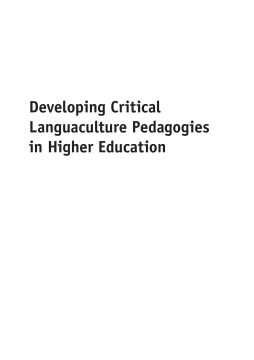
Additional Information
Book Details
Abstract
Despite widespread agreement about the need to develop interculturally competent graduates, there is a lack of agreement about how this goal may be achieved in practice. This is significant as universities around the world, particularly in English-speaking countries, have espoused an interculturally-aware vision for their future graduates and turned to language education, as an inherently intercultural activity, to expose students to a world which is linguistically and culturally different from their own. This book focuses on narrowing the gap between the often conflicting theoretical and practical imperatives faced by language teachers in an internationalised higher education context. It does so by providing comprehensive conceptual discussions of emerging critical intercultural language pedagogies as well as empirical accounts and case studies from the frontline.
Adriana Raquel Díaz is Associate Lecturer at the School of Languages and Linguistics, Griffith University, Australia. Her main research activities focus on the development of intercultural competence, the variables affecting the implementation of intercultural language curricula and teaching methodologies as well as teachers' journeys in the development of intercultural language learning pedagogies.
The book is reader-friendly and thus, capable of attracting and holding readers’ attention. Moreover, it is a book written for quite a wide readership, including scholars of applied linguistics and language teaching, language teachers, language curriculum designers as well as students of linguistics. In closing, I have no hesitation to suggest this book to anyone who is interested in language and culture teaching, particularly in tertiary education irrespective of their context of study and work.
Ali Karakas, Mehmet Akif Ersoy University, Burdur, Turkey
This book constitutes a big step forward in the field of language and culture teaching. It contains a comprehensive and insightful discussion of the gap between theory and practice and presents a very thoughtful analysis of an innovative teacher-researcher collaborative project aimed at investigating different ways of developing university students' critical languaculture awareness as part of the internationalisation process.
Based on her own research, Adriana Diaz's Guide to Practice provides a pedagogic framework that seeks to bridge the gap between theory and practice as well as between language and culture in the language classroom. This book invites readers to rethink and reflect critically about the complex process of teaching language AND culture, which is an increasingly key issue in a more integrated approach to language and culture in language education.
Table of Contents
| Section Title | Page | Action | Price |
|---|---|---|---|
| Contents | v | ||
| Figures and Tables | vii | ||
| Foreword | ix | ||
| Preface | xiii | ||
| Introduction | xv | ||
| Part 1 The Theory/Practice Gap in Language and Culture Pedagogies in Higher Education | 1 | ||
| 1 Stumbling Blocks to Bridging the Theory/Practice Gap | 3 | ||
| 2 From Stumbling Blocks into Building Blocks | 25 | ||
| Part 2 Theory Versus Practice and the Realm of Possibility | 61 | ||
| 3 Case Studies of Curricular Innovation | 62 | ||
| 4 The Good, The Bad and The Feasible | 111 | ||
| Part 3 Bridging the Gap Without Falling into the Precipice | 140 | ||
| 5 Articulating the Feasible with Sustainable Innovation | 141 | ||
| Conclusion: Prospects for a Field in Transition | 158 | ||
| Appendix 1: Case Study A: Languaculture Workshop Presentation in Italian Culture Context Subject | 169 | ||
| Appendix 2: Case Study B: Italian Language Subject Sample Lesson Plan | 171 | ||
| Appendix 3: Case Study B: Languaculture Workshop Presentation in Italian Language Subject | 173 | ||
| Appendix 4: Case Study C: Chinese Language Subject | 174 | ||
| Appendix 5: Case Study D: Discovery Page | 175 | ||
| References | 177 | ||
| Index | 194 |
